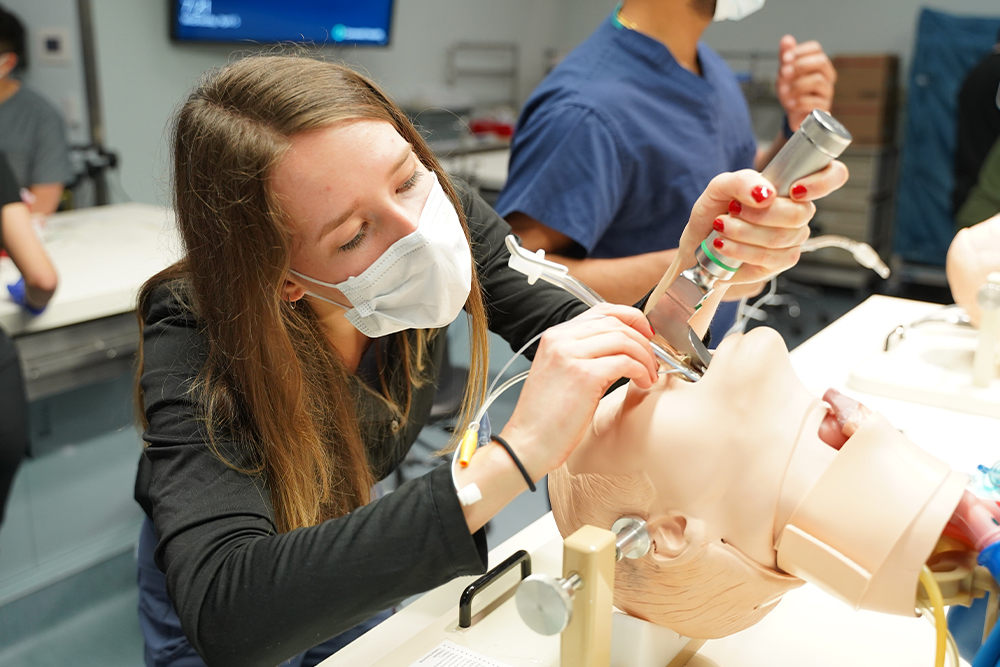The OUWB Emergency Medicine Interest Group recently held a clinical skills night at Corewell Health William Beaumont University in Royal Oak.
Nearly 30 medical students from OUWB attended the event designed to help them practice skills often used in emergency rooms.
Led by Corewell Health clinical faculty, students practiced intubation, IV lines, lumbar puncture, ultrasounds, and suturing.
Sylvia Kashat, M2, president of EMIG for 2022-23, says the intent is to prepare students for the next phase of their medical education.
“Once we start third year (of medical school), we go right into clerkships where we’re doing these things every single day,” she says. “Obviously, one night isn’t enough to teach everything, but it gets some exposure so that we’re at least more comfortable doing hands-on work.”
“It also helps students realize if it’s the kind of stuff they like, or don’t like,” adds Kashat.
Similar events are held throughout the school year by other student organizations, such as the OB/GYN Interest Group (OGIG) and the Pediatric Interest Group (PIG).
The EMIG skills event was held at the Marcia & Eugene Applebaum Simulation Learning Institute that is at Corewell Health’s main Royal Oak campus.
No actual patients were involved. At one station, intubation was done using special head trainers. At another, suturing was practiced by using stitches on chicken fillets. Simulation tools also were used at the other three stations.
“It’s very easy to watch a doctor do these things, but…you don’t realize how much coordination it takes,” says Kashat. “It can be really eye-opening to experience this before going into rotations.”
 |
| Steven Joseph, M.D., helps Frosilda Pushani, M1, practice suturing skills using a piece of chicken. |
Doctors like Steven Joseph, M.D., an emergency medicine physician, and assistant professor in emergency medicine, volunteered to help with the event. (Joseph also serves as faculty advisor to EMIG.)
“Being able to introduce students to a part of the emergency medicine world and watching them go from apprehension with a procedure to enthusiasm with that procedure in a short amount of time is a really fulfilling part of medical education,” says Joseph.
“As an EM doc, I hope that the students get an introduction to common procedures in emergency medicine and hope they get questions about emergency medicine as a career answered by emergency medicine attending physicians and residents,” he adds. “As a medical educator, I hope students just get the opportunity to have fun while learning a valuable skill that helps their patients later in their careers.”
Costs are covered by OUWB. Kashat says the best way to measure the value of the program is the anecdotal feedback students provide.
Kellan Martin, M1, is president of EMIG for the 2023-23 school year.
“Being able to get hands-on work now and explore options for specializing is a really great opportunity,” she said. “Plus, we’re able to connect with clinical faculty and bond over the excitement of it all.”
Sachin Pathangey, M1, says that he enjoys making the connection between what is learned in lecture and how it applies to a clinical setting.
“The ultrasound of the heart was so incredible because we just learned about cardiology,” he says. “It’s stuff you don’t really get to see when we’re just studying.”
Vincent Le, M1, says he was grateful to the residents and attending physicians for their time.
“They not only help us practice skills, but also let us know why these things are important,” he says. “It’s just a neat way to synthesize what we’ve learned in class and how it applies clinically.”
For more information, contact Andrew Dietderich, marketing writer, OUWB, at [email protected].
To request an interview, visit the OUWB Communications & Marketing webpage.
This work is licensed under a Creative Commons Attribution-NonCommercial 4.0 International License.


